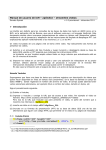Download Akamai MultiPlayer for Adobe Flash: User Guide
Transcript
Akamai
Multi
Player
for
Adobe
Flash:
User
Guide
Akamai
MultiPlayer
for
Adobe
Flash:
User
Guide
Contents
Introduction ................................................................................................................................................................ 2
MultiPlayer
features.................................................................................................................................................... 2
Player
components...................................................................................................................................................... 3
Video
display............................................................................................................................................................ 4
Playback
control
bar ................................................................................................................................................ 4
Play
list
panel ........................................................................................................................................................... 4
Context
menu .......................................................................................................................................................... 5
Content
preparation.................................................................................................................................................... 5
Configuration
and
deployment ................................................................................................................................... 5
MultiPlayer
configuration
tool................................................................................................................................. 5
Advanced
configuration
and
deployment
considerations....................................................................................... 6
Troubleshooting .......................................................................................................................................................... 7
Debug
trace
panel.................................................................................................................................................... 7
Appendix
A:
Configuration
options ............................................................................................................................. 8
Appendix
B:
Example
deployment
web
page............................................................................................................ 10
Appendix
C:
Dynamic
stream
switching .................................................................................................................... 12
Appendix
D:
References ............................................................................................................................................ 12
Articles ................................................................................................................................................................... 12
Sample
content
links.............................................................................................................................................. 13
Page
1
2/27/2009
Akamai
Multi
Player
for
Adobe
Flash:
User
Guide
Introduction
This
document
is
a
quick
reference
for
using
the
Akamai
MultiPlayer
for
Adobe
Flash.
The
Akamai
MultiPlayer
is
a
ready‐to‐deploy
media
player
application
for
Flash
media
content.
It
is
light,
flexible,
and
based
on
open
standards.
This
user
guide
will
walk
you
through
the
features
in
the
Akamai
MultiPlayer
and
describe
how
to
deploy
it
for
use
with
your
Flash
media
content.
MultiPlayer
features
The
Akamai
MultiPlayer
offers
a
robust
platform
based
on
Adobe
ActionScript
3
for
the
playback
of
a
wide
variety
of
streaming
and
progressive
media
delivered
by
the
Akamai
platform.
The
figure
below
shows
the
playback
of
a
play
list
of
on‐demand
Flash
video
streaming
content
in
the
MultiPlayer.
Figure
1:
The
playback
of
a
play
list
through
the
Akamai
MultiPlayer.
Specific
features
include:
•
•
•
Dynamically
scalable.
All
views
are
re‐scaled
and
positioned
each
time
the
flash
player
is
resized.
Two
layout
modes.
Different
layouts
for
the
controls
and
play
list
that
can
be
toggled
at
anytime
during
playback:
o Overlay,
where
the
controls
are
overlaid
over
the
video
and
hide
themselves
if
you
mouse‐off
the
player.
o Side‐by‐side,
where
the
controls
are
permanently
on
the
screen
and
the
playlist
view
is
located
to
the
right
of
the
video
content
area.
Four
video
scaling
modes.
Different
video
scaling
that
can
be
toggled
at
anytime
during
playback:
o Fit,
where
the
video
is
scaled
as
large
as
possible
to
fit
within
the
confines
of
the
player
while
still
preserving
its
native
aspect
ratio.
o Stretch,
where
the
video
is
is
stretched
to
fit
exactly
within
the
confines
of
the
player.
Native
aspect
ratio
is
not
preserved.
Page
2
2/27/2009
Akamai
Multi
Player
for
Adobe
Flash:
User
Guide
Native,
where
the
video
is
scaled
to
the
native
size
it
was
encoded
at.
Note
that
this
size
may
be
larger
than
the
player
that
is
trying
to
render
the
video,
in
which
case
the
video
will
be
centered
within
the
available
player
space.
o Native
or
smaller,
where
the
video
will
be
scaled
to
its
native
size
unless
that
is
larger
than
the
player
in
which
case
"fit"
scaling
will
be
invoked.
Standard
playback
controls.
Common
playback
functionality
including
play/pause,
volume,
scrub
(seek),
current
position,
duration.
Full
screen
mode.
Maximize
the
video
display
dimensions
and
retain
access
to
the
playback
controls.
Social
media
options.
Provides
access
to
“link”
and
“embed”
data
for
player
re‐distribution.
Playlist
visibility.
Hide
or
show
the
play
list
during
playback.
Troubleshooting.
Built‐in
debug
screen
to
assist
with
debugging
connection
and
play
back
problems.
Multiple
delivery
formats.
Play
content
using
a
variety
of
delivery
options:
o
•
•
•
•
•
•
On‐demand
Streaming
Live
Streaming
Progressive
Download
Yahoo!
Media
Stream
OS
RSS
Play
Lists
Metafiles
Akamai
Media
Delivery
(AMD)
Stream
OS
Yes
Yes
Yes
No
No
Dynamic
Stream
Switching
Play
Lists
Yes
Yes
Yes
Yes
Yes
Yes
No
Notes
1. Play
list
support
currently
includes
any
play
list
that
is
compliant
with
the
Yahoo!
Media
RSS
specification
and
has
a
file
extension
of
‘.xml’
or
‘.rss’.
2. Stream
OS
metafiles
includes
types
1,
2,
and
4.
3. Dynamic
streaming
switching
includes
support
for
the
SMIL
1.0
definition
supported
by
the
Adobe
FLVPlayback
component.
The
section
‘Configuration
and
deployment’
provides
more
details
and
Appendix
C
provides
a
sample.
Player
components
The
MultiPlayer
has
several
components.
These
include:
1.
2.
3.
4.
Video
display
Playback
control
bar
Play
list
panel
Context
menu
Figure
2
below
shows
these
components.
Page
3
2/27/2009
Akamai
Multi
Player
for
Adobe
Flash:
User
Guide
Figure
2:
MultiPlayer
components.
Video
display
The
video
display
is
where
the
video
can
be
viewed.
Playback
control
bar
The
playback
control
bar
enables
the
end‐user
to
do
the
following:
•
•
•
•
•
•
•
•
•
Play
and
pause
the
current
content
playing
Scrub
(seek)
through
the
timeline
of
the
current
content
playing
Adjust
the
volume
(audio
level)
View
the
current
and
remaining
time
for
the
current
content
playing
View
an
indication
of
how
much
of
the
current
content
playing
has
downloaded
(progressive
download
only)
Toggle
the
play
list
display
mode
(displayed
only
when
a
play
list
is
in
use)
Toggle
full
screen
display
mode
Provide
link
and
embed
code
for
the
player
View
an
indication
of
quality
(dynamic
streaming
only)
Play
list
panel
The
play
list
panel
lists
the
content
in
a
play
list.
The
play
list
panel
enables
end‐users
to
do
the
following:
•
•
•
•
View
the
metadata
for
each
item
in
the
play
list
View
an
indication
of
which
item
is
currently
playing
Scroll
up
and
down
through
the
play
list
Select
an
item
in
the
play
list
for
playback
Page
4
2/27/2009
Akamai
Multi
Player
for
Adobe
Flash:
User
Guide
Context
menu
The
context
menu
is
a
floating
menu
that
can
be
activated
by
right
clicking
anywhere
on
the
player.
The
context
menu
enables
end‐users
to
do
the
following:
•
•
•
•
•
•
Toggle
the
layout
mode
Toggle
the
video
scaling
mode
Toggle
the
debug
trace
panel
Toggle
the
switching
mode
(manual
versus
automatic,
dynamic
streaming
only)
Manually
switch
to
content
with
a
higher
data
rate
(dynamic
streaming
only)
Manually
switch
to
content
with
a
lower
data
rate
(dynamic
streaming
only)
Content
preparation
The
following
should
be
considered
when
preparing
content:
•
•
•
The
MultiPlayer
supports
all
Flash
video
and
audio
formats
and
in
particular
all
streaming
formats
supported
by
FMS
3.5.
Encoding
guidelines
can
be
found
in
the
Adobe
Developer
Connection
community
site
at
http://www.adobe.com/devnet/.
The
MultiPlayer
supports
RSS
feeds
for
play
lists.
Specifically
this
means
that
you
must
comply
with
the
RSS
2.0
and
Yahoo!
Media
RSS
specifications.
For
more
information
on
these
specifications,
check
out
the
links
in
Appendix
D
of
this
document.
It
is
important
to
note
that
if
you
host
the
RSS
feed
on
a
different
domain
than
where
your
player
(SWF)
resides,
you
will
need
a
cross‐domain
file
in
the
root
path
of
the
web
server
where
the
RSS
feed
resides.
Dynamic
streaming
requires
a
reference
to
various
properties
for
all
of
your
content
derivatives.
The
MultiPlayer
requires
the
use
of
a
SMIL
document
for
this
purpose.
For
more
information
on
the
syntax
of
the
SMIL
document,
check
out
the
sample
in
Appendix
C
of
this
document.
If
you
host
the
SMIL
document
on
a
different
domain
than
where
your
player
(SWF)
resides,
you
will
need
a
cross‐domain
file
in
the
root
path
of
the
web
server
where
the
SMIL
document
resides.
Configuration
and
deployment
Use
of
the
MultiPlayer
requires
configuration
and
deployment
like
any
Flash
(SWF)
application.
A
configuration
tool
is
available,
which
enables
a
simple,
intuitive
approach
to
configuring
and
deploying
the
player.
MultiPlayer
configuration
tool
This
tool
will
enable
you
to:
•
•
Intuitively
configure
the
customizable
options
in
the
player.
Preview
the
player
with
the
options
configured.
Page
5
2/27/2009
Akamai
Multi
Player
for
Adobe
Flash:
User
Guide
Generate
and
export
the
syntax
(based
on
SWFObject)
necessary
to
reference
the
player
in
your
web
page.
The
tool
is
written
in
Flex
and
requires
the
Flash
Player
plug‐in.
The
tool
can
be
accessed
from
the
OVP
SourceForge
site
here:
http://openvideoplayer.sourceforge.net/get‐started
For
more
details
on
the
configuration
options,
please
refer
to
‘Appendix
A:
Configuration
options’
in
this
document.
•
Advanced
configuration
and
deployment
considerations
Using
the
MultiPlayer
does
not
require
the
configuration
tool.
Configuration
and
deployment
of
the
player
outside
of
the
configuration
tool
can
provide
additional
flexibility
but
requires
a
good
understanding
of
how
to
deploy
a
Flash
(SWF)
application.
Specifically:
1.
2.
3.
4.
Create
a
web
page
that
references
the
MultiPlayer
configuration
Configure
the
MultiPlayer
Test
the
player
on
your
web
server
Deploy
the
web
page
Create
a
web
page
Using
the
Akamai
Basic
Media
Player
requires
you
to
reference
the
player
in
a
web
page
just
like
any
Flash/Flex
application.
Commonly
known
as
“embedding”,
this
can
be
accomplished
many
ways
and
can
involve
several
languages
such
as
HTML
and
JavaScript,
all
of
which
depends
on
the
considerations
you
make
around
the
configuration
options
for
the
Flash
Player
plug‐in
and
the
Basic
Media
Player,
including
version
support,
end‐user
installation
experience,
and
more.
For
more
details
on
Flash
Player
detection
and
installation,
visit
the
Flash
Player
Developer
Center
in
the
Adobe
Developer
Connection,
a
resource
for
learning
about
Adobe
products
and
services:
http://www.adobe.com/devnet/flashplayer/detection_installation.html
For
a
great
perspective
on
the
considerations
for
embedding
Flash
content,
visit:
http://www.alistapart.com/articles/flashembedcagematch
SWFObject
is
highly
recommended
for
embedding
the
Akamai
Basic
Media
Player.
Appendix
B
provides
an
example
of
the
syntax
that
is
required
using
SWFObject.
For
more
details
on
this
method,
visit:
http://code.google.com/p/swfobject/
Page
6
2/27/2009
Akamai
Multi
Player
for
Adobe
Flash:
User
Guide
Configure
the
MultiPlayer
After
you
have
created
your
web
page,
you
next
need
to
define
the
configuration
options
for
the
player.
All
options
for
the
MultiPlayer
are
configured
using
the
FlashVars
property
of
the
Adobe
Flash
Player
plug‐in.
This
property
provides
an
efficient
method
of
dynamically
passing
the
configuration
options
for
the
MultiPlayer
from
the
web
page
when
the
player
is
loaded.
For
more
details
on
the
FlashVars
property,
visit:
http://kb.adobe.com/selfservice/viewContent.do?externalId=tn_16417
Test
the
player
After
you
have
configured
the
player
the
next
step
is
to
test
the
web
page
that
references
the
player.
If
possible,
you
should
test
it
on
various
versions
of
web
browser
applications
(Fire
Fox
2/3,
Internet
Explorer
6/7,
Safari,
and/or
Opera)
and
various
versions
of
operating
systems
(Windows
XP/Vista,
Mac
OS,
and/or
Linux)
to
ensure
the
optimal
end‐user
experience.
Keep
in
mind
that
SWFObject
uses
syntax
that
provides
a
wide
range
of
browser
and
operating
system
compatibility.
Deploy
the
web
page
Once
you
have
determined
that
your
player
is
configured
and
functions
as
desired,
you
simply
need
to
deploy
your
web
page
into
your
production
web
site.
Troubleshooting
Debug
trace
panel
The
built‐in
debug
trace
panel
provides
a
log
for
troubleshooting
playback
issues.
Figure
3
below
shows
the
debug
trace
panel.
Page
7
2/27/2009
Akamai
Multi
Player
for
Adobe
Flash:
User
Guide
Figure
3:
Debug
trace
panel
The
panel
displays
trace
statements
for
significant
application
events,
including
all
underlying
NetConnection
and
NetStream
status
events,
with
latest
events
at
the
top.
This
can
be
critical
along
with
end‐user
details
such
as
operating
system,
browser,
and
plug‐in.
Clear
and
Copy
buttons
are
provided
to
respectively
clear
the
contents
of
the
panel
and
copy
the
contents
to
the
clipboard
to
send
to
others
for
further
analysis.
Appendix
A:
Configuration
options
The
following
is
a
list
of
required
and
optional
configuration
options.
Name
Description
Necessity
Defined
Values
Default
Value
Notes
src
The
source
URI
of
the
content
which
the
player
is
expected
to
play.
Required
This
must
be
a
valid
and
well
structured
reference
to
AMD
or
Stream
OS
content,
or
a
HTTP
link
to
progressive
content
on
any
web
server.
mode
The
layout
mode.
Optional
sidebyside
fit
333333
“0x”
or
“#”
are
not
required.
•
overlay
•
sidebyside
•
fit
•
stretch
•
native
•
nativeorsmaller
scaleMode
frameColor
The
starting
scaling
mode
for
the
video.
The
HEX
value
for
the
frame
color.
Optional
Optional
Page
8
2/27/2009
Akamai
Multi
Player
for
Adobe
Flash:
User
Guide
fontColor
The
HEX
value
for
the
frame
color.
Optional
CCCCCC
“0x”
or
“#”
are
not
required.
themeColor
The
HEX
value
Optional
for
the
frame
color.
Used
for
button
mouse‐
over
highlights,
scrub
bar
shading,
volume
control
shading,
and
playlist
title
font
color.
0395D3
“0x”
or
“#”
are
not
required.
autostart
Defines
whether
the
video
starts
playing
after
the
player
is
loaded.
Optional
true
If
set
to
"false",
the
player
will
render
the
first
keyframe
in
the
video
to
create
a
splash
screen
and
then
stop.
link
The
URL
which
the
user
can
use
to
link
to
a
mounted
instance
of
the
player.
Optional
This
parameter
must
be
escaped
(URL‐encoded)
or
else
it
will
mask
other
FlashVar
attributes.
Note
that
the
button
to
surface
the
link/embedded
panel
will
only
be
visible
if
either
the
link
or
embed
parameter
has
a
Page
9
2/27/2009
Akamai
Multi
Player
for
Adobe
Flash:
User
Guide
non
empty‐
string
value.
embed
The
URL
which
the
user
can
use
to
embed
the
player.
Optional
This
parameter
must
be
escaped
(URL‐encoded)
or
else
it
will
mask
other
FlashVar
attributes.
Note
that
the
button
to
surface
the
link/embedded
panel
will
only
be
visible
if
either
the
link
or
embed
parameter
has
a
non
empty‐
string
value.
Notes
1. In
order
for
full
screen
mode
to
be
functional,
the
player
must
be
embedded
in
the
web
page
with
the
‘allowFullScreen’
set
to
“true”.
2. The
minimum
embed
width
for
the
player
varies
depending
on
how
it
is
configured.
See
the
table
below
for
the
minimum
width
in
various
configurations:
Overlay
Mode
Full
screen
or
Share
(pixels)
390
360
Play
list
content
Single
file
playback
Side‐by‐Side
Mode
Full
screen
and
Share
(pixels)
420
390
Full
screen
or
Share
(pixels)
680
360
Full
screen
and
Share
(pixels)
720
390
Appendix
B:
Example
deployment
web
page
As
an
example,
view
the
HTML
script
below.
This
requires
that
the
swfobject.js
and
expressInstall.swf
files
to
be
located
in
the
same
folder
as
the
HTML
file:
Page
10
2/27/2009
Akamai
Multi
Player
for
Adobe
Flash:
User
Guide
<!DOCTYPE html PUBLIC "-//W3C//DTD XHTML 1.0 Strict//EN" "http://www.w3.org/TR/xhtml1/DTD/xhtml1strict.dtd">
<html xmlns="http://www.w3.org/1999/xhtml" lang="en" xml:lang="en">
<head>
<title>SWFObject dynamic embed</title>
<meta http-equiv="Content-Type" content="text/html; charset=iso-8859-1" />
<script type="text/javascript" src="swfobject.js"></script>
<script type="text/javascript">
var flashvars = {
src: "rtmp%3A//cp27886.edgefcs.net/ondemand/14808/nocc_small307K.flv",
autostart: "true",
themeColor: "0395d3",
mode: "sidebyside",
scaleMode: "fit"
};
var params = {};
var attributes = {
id: "myPlayer",
name: "myPlayer",
allowFullScreen: "true"
};
swfobject.embedSWF("AkamaiFlashPlayer.swf", "myPlayerGoesHere", "802", "489", "9.0.0",
"expressInstall.swf", flashvars, params, attributes);
</script>
</head>
<body>
<div id="myPlayerGoesHere">
<a href="http://www.adobe.com/go/getflashplayer">
<img src="http://www.adobe.com/images/shared/download_buttons/get_flash_player.gif" alt="Get Adobe Flash
player" />
</a>
Page
11
2/27/2009
Akamai
Multi
Player
for
Adobe
Flash:
User
Guide
</div>
</body>
</html>
Appendix
C:
Dynamic
stream
switching
Adobe
dynamic
stream
switching
requires
derivatives
of
your
source
content
at
specific
data
rates
you
define
and
the
media
player
application
must
know
about
these
derivatives.
This
can
be
accomplished
using
a
SMIL
document
that
has
a
format
supported
by
Adobe
and
the
FLVPlayback
component.
Below
is
a
sample
file:
<smil>
<head>
<meta base="rtmp://cp67126.edgefcs.net/ondemand" />
</head>
<body>
<switch>
<video
src="mp4:mediapm/ovp/content/demo/video/elephants_dream/elephants_dream_768x428_24.0fps_408kbps.mp4"
system-bitrate="408000"/>
<video
src="mp4:mediapm/ovp/content/demo/video/elephants_dream/elephants_dream_768x428_24.0fps_608kbps.mp4"
system-bitrate="608000"/>
<video
src="mp4:mediapm/ovp/content/demo/video/elephants_dream/elephants_dream_1024x522_24.0fps_908kbps.mp4"
system-bitrate="908000"/>
<video
src="mp4:mediapm/ovp/content/demo/video/elephants_dream/elephants_dream_1024x522_24.0fps_1308kbps.mp4"
system-bitrate="1308000"/>
<video
src="mp4:mediapm/ovp/content/demo/video/elephants_dream/elephants_dream_1280x720_24.0fps_1708kbps.mp4"
system-bitrate="1708000"/>
</switch>
</body>
</smil>
NOTE:
If
you
host
the
SMIL
document
on
a
different
domain
than
where
your
player
(SWF)
resides,
you
will
need
a
cross‐domain
file
in
the
root
path
of
the
web
server
where
the
SMIL
document
resides.
Appendix
D:
References
Articles
Adobe
Developer
Connection:
Flash
Player
Developer
Center:
Detection
and
Installation
http://www.adobe.com/devnet/flashplayer/detection_installation.html
Flash
Embedding
Cage
Match
http://www.alistapart.com/articles/flashembedcagematch
Page
12
2/27/2009
Akamai
Multi
Player
for
Adobe
Flash:
User
Guide
Google
Code:
SWFObject
http://code.google.com/p/swfobject/
Adobe
Tech
Note:
Using
FlashVars
to
pass
variables
to
a
SWF
http://kb.adobe.com/selfservice/viewContent.do?externalId=tn_16417
RSS
2.0
specification
http://www.rssboard.org/rss‐specification
Yahoo!
Media
RSS
specification
http://search.yahoo.com/mrss
Sample
content
links
The
following
sample
content
links
are
provided
for
testing
purposes:
•
•
•
•
•
•
•
•
•
AMD
on‐demand
streaming
video
(H.264):
o rtmp://cp67126.edgefcs.net/ondemand/mp4:mediapm/ovp/content/demo/video/elephants_dre
am/elephants_dream_768x428_24.0fps_608kbps.mp4
AMD
progressive
download
video
(H.264):
o http://mediapm.edgesuite.net/ovp/content/demo/video/elephants_dream/elephants_dream_76
8x428_24.0fps_608kbps.mp4
AMD
live
streaming
video
(H.264):
o rtmp://cp34973.live.edgefcs.net/live/Flash_Live_Benchmark@632
AMD
dynamic
streaming:
o http://mediapm.edgesuite.net/ovp/content/demo/smil/elephants_dream.smil
AMD
on‐demand
streaming
audio
only
(MP3):
o rtmp://cp67126.edgefcs.net/ondemand/mediapm/ovp/content/test/video/nocc_small.mp3
Stream
OS
on‐demand
streaming
video,
type
4
metafile
(H.264):
o http://products.edgeboss.net/flash/products/content/demo/video/elephants_dream_768x428_2
4.0fps_608kbps.mp4?xmlvers=4
Stream
OS
progressive
download
video
(H.264):
o http://products.edgeboss.net/download/products/content/demo/video/elephants_dream_768x4
28_24.0fps_608kbps.mp4
Stream
OS
RSS
feed
(on‐demand
streaming
video,
VP6):
o http://rss.streamos.com/streamos/rss/genfeed.php?feedid=1675&groupname=products
Stream
OS
RSS
feed
(progressive
download
video,
VP6):
o http://rss.streamos.com/streamos/rss/genfeed.php?feedid=1679&groupname=products
Page
13
2/27/2009
Akamai
Multi
Player
for
Adobe
Flash:
User
Guide
Page
14
2/27/2009
























